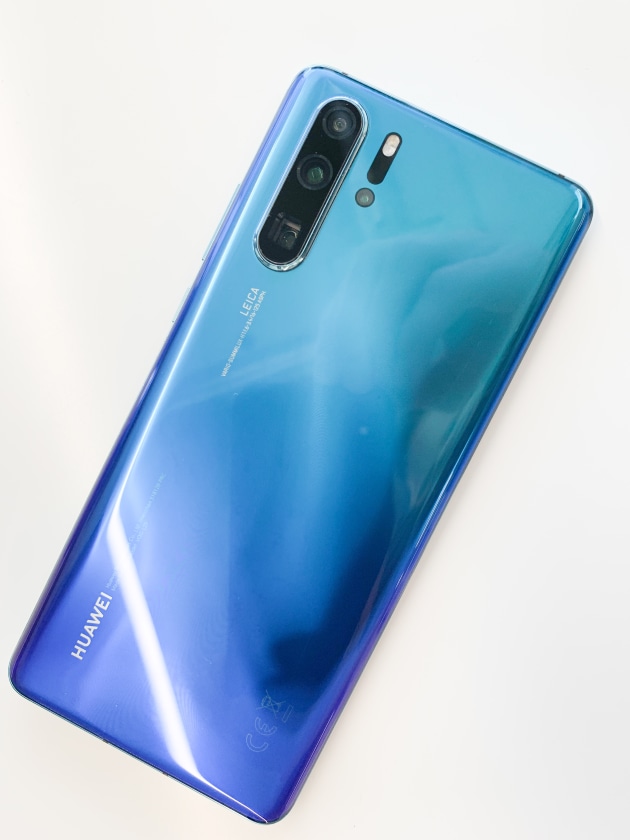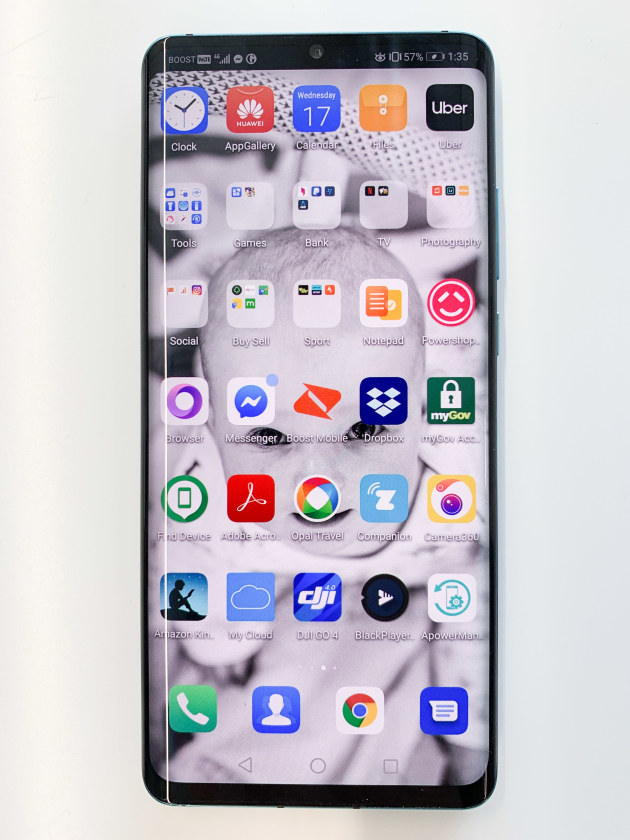Review: Huawei P30 Pro
Launching almost a year to the day after Huawei's last flagship smartphone touched down, Huawei has announced the P30 Pro, the new flagship smartphone for the Chinese manufacturer.
It comes with the bold catchline that it will 'rewrite the rules of photography', and although this might be a tad-hyperbolic, there's still a lot to like in this powerhouse device with the best smartphone camera we've used yet.

Design
The P30 Pro feels like you would expect a premium flagship to feel, with smooth curves and a classy curved rear glass panel.
It measures 158 x 73.4 x 8.4mm, and while it may be thicker than both the Galaxy S10 Plus and iPhone XS Max, it doesn't feel it. Visually this is helped by the almost bezel-less screen, like that on its sibling the Mate 30, with the P30 Pro also picking up the same curved Gorilla Glass glass style cover as found on the Samsung Galaxy S10 Plus.

We are almost at the point where smartphone manufacturers can ditch the top and bottom bezels entirely, and the P30 Pro has just the thinnest of these, one to house the forward facing camera and one very thin bezel at the base. This reduction is made possible by moving the fingerprint sensor behind the glass, a feature that we'd expect more smartphone camera manufacturers to adopt soon.
It's worth noting that the P30 Pro is a big phone, and one that's quite slippery too, thanks to those large front and rear glass panels. You'll find the included plastic sleeve is much-needed to give it a bit of grip as well as protection.

Unfortunately for those who prefer their smartphones to be discreet, the P30 only comes in two fairly funky colours in Australia. Our review unit came in 'Aurora', a love it or leave it pearlescent finish, (admittedly we quite liked it) but there's also the fetchingly-titled 'Breathing Crystal', a light blue/purple colour which has a distinct 'unicorn-vomit' feel to it. But putting aside our conservatism, if you are one of those people who likes to stand out among the sea of black and grey smartphones, you'll be very happy with these bold options.
Finally the Huawei P30 Pro comes with an IP68 rating, meaning it’s dust- and water-resistant, and able to withstand being submerged for up to 30 minutes in fresh water.
Display
The Huawei P30 Pro features a 6.47-inch OLED display with a 1080 x 2340 resolution, and although this isn't exactly class leading - Sony's Xperia 1 offers a 4K display, and Samsung and LG flagships both feature QHD panels - it looks great.

However as the first smartphone we've used with a curved display, it is a little unusual to use at first. You might find yourself readjusting your reading style as the text curves ever so slightly on the edges and the light often catches the bend in the glass.
Camera
That 'Rewrite the rules of photography' catchline starts to make a little more sense with you look at the camera specs of the Huawei P30 Pro.
It features a triple-camera setup (quad-camera, if you count the time-of-flight sensor), a 5x optical zoom, 10x hybrid zoom and huge 50x digital zoom. The P30's optical performance is clearly no flash-in-the-pan either, as it is currently the highest rated smartphone on DXOMark, beating previous record holders and fellow Huawei smartphones the Mate 20 Pro and P20 Pro.

As it has for the last few years, Huawei's relationship with German camera-manufacturer Leica continues with the P30 Pro. We've been told this relationship extends to the use of Leica technology in the sensors and optical technology, but you also get that desirable Leica logo on the back panel as well as a nice minimalist Leica font throughout the camera settings and menu screens.
Back to the cameras. Each of the zooms have their own sensor - a 40MP sensor on the main camera, 8MP for the telephoto camera, 20MP for the ultra-wide angle lens and also a ToF (time-of-flight) depth-sensing camera.
The ToF sensor is used to define depth for portrait shots, creating that shallow depth of field effect that more and more smartphones are now offering. On the front is a 32MP selfie camera, and although it doesn't get any of the ToF features, it still takes sharp, detailed shots.

By default, the 40MP main rear camera will only generate a 10MP file, although a change in settings will allow you to take advantage of the whole sensor and all the additional detail that comes with it, with one caveat - you can't use the zooom features. For most applications I found the default 10MP setting more than adequate, but it's nice to have the option of going bigger and more detailed if you want it.
The 5x, 10x and 50x zoom capabilites make up one of the P30's headline features and bring a level of technology we haven't seen in a smartphone camera before. The Huawei P30 Pro introduces the first commercially available 135mm Periscope telephoto lens to achive such a huge focal length, equivalent to 125mm at 5x.
Named after the periscope on a submarine that lets people inside see what's happening on the surface, a periscope zoom lens system uses an angled mirror to hide a zoom mechanism in the smartphone body. When you take an image, an external lens reflects off the mirror while another lens transmits the image to the sensor.

In use, you’ll need to keep still for a second after pressing the shutter button while the P30 Pro gathers extra information in order to produce the cleanest image and correct for camera shake. The stabilisation does much to make images taken at the full extent of the 50x zoom usable, but we found where the zoom displayed the best results was with the 5x and 10x zoom.
To be fair you'll probably find the times you need a 50x zoom fairly limited, while the results, despite being pretty good for a smartphone, won't make you ditch that 400mm lens quite yet. With a tripod is where this feature comes into it's own.
We thought the P20 Pro was impressive in low light, but the P30 Pro takes it to another level. Huawei boast some pretty impressive (and borderline ridiculous) high ISO abilities in the new smartphone, with the company saying the P30 Pro can shoot up to a maximum ISO of 409,600.
Combine this with the Optical Image Stabilisation, Artificial Image Stabilisation, and wide f/1.6 wide aperture, and the P30 Pro is seemingly capable of seeing in the dark.

At the Sydney media event for the P30 Pro we were taken into a darkened and curtained-off room to test the low light capabilities of the camera. The model in one corner was only lit by a small strip light at ground level at the opposite end of the room that was really only there to stop people from tripping over.
Where our eyes could see practically nothing, the P30 Pro saw plenty, with the resulting images managing to retain plenty of detail and little noise. it's impressive, and even more so when you consider these results came from the standard camera, not using the night mode feature which lends itself better to longer exposures.
According to Huawei, part of the low light improvements are down to a switch from the industry standard RGB (red green blue) sensor design to a RYYB (red yellow yellow blue) design, which the company claims lets the sensor pull in more light.
Possibly Huawei's use of high ISO noise reduction has improved in the P30 Plus too, but regardless, the results deliver the best low-light performance of any smartphone camera we've used.


Finally the P30 Pro has a macro feature that offers a super close-focussing distance of just 2.5cm. To find it, you have to first turn on the ultra wide angle lens on the right side of the screen in photo mode.
Whether this is a true macro lens or just takes advantage of the close-focussing capabilities of wide angle lenses we can't be sure, but it clearly makes a difference, with macro images displaying impressive levels of fine detail.
Video
The P30 Pro offers 3840x2160 (4K UHD) (30 fps), 1920x1080 (Full HD), and 1280x720 (HD) (960 fps). Image stabilisation is excellent, and the new editing features built-in make editing short videos on the fly a breeze.
Where video modes come short is if you want to zoom while filming. It's likely the processing required to film at the full 50x is a bridge too far for the P30 Pro's processor, so it's limited to 15x.
Performance
Speaking of processors, the Huawei P30 Pro features a Kirin 980 chipset and 8GB of RAM, which is plenty for most real world use and means load times and rendering is super fast. The P30 Pro has Google’s Android 9 Pie operating system, although this is skinned by Huawei's own EMUI.
Finally the P30 Pro packs a monster 4,200mAh battery, bigger than any in rival smartphones, and is easily capable of a day and half of heavy use before you'll need to charge it. We also liked that the reverse wireless charging feature as seen in the Mate 20 Pro has also made its way to the P30 Pro. This allows you to charge other Qi wireless charging supported devices on the rear of the P30 Pro.
Pricing
The Huawei P30 Pro price starts at AU$1,599, which makes it one of the most expensive handsets on the market, matching the price of the Samsung Galaxy S10 Plus, but cheaper than the iPhone XS Max.
Unfortunately along with the limited choice of colours, there's also just two sizes, 128GB and 256GB, with a 512GB version not making it to Australia.
Final thoughts
The Huawei P30 Pro offers impressive performance, a sharp (although not class-leading) screen, and most importantly for photographers, a camera that delivers excellent results in all sorts of lighting conditions. It's not cheap, but few flagship phones are in 2019.
If you're a photographer looking for a b-camera or something for your pocket for when your main camera isn't at hand, or if you just want to leave the camera at home and just take your phone, you could do much worse than the P30 Pro.


